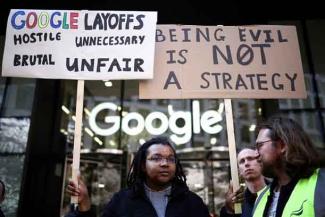Big Tech Layoffs: Another Capitalist Crisis?
In the two decades since the burst of the ‘Dot-com’ bubble in 2003, big-tech had yet again become the primary location for speculative investments by major capitalist entities. The tech industry has boasted of its near constant and exponential growth over the past decades, demanding and receiving preferential treatment from governments around the world.
Major tech companies like Facebook (now Meta) and Amazon actually nearly doubled their workforce when the pandemic started. In fact, big-tech firms registered record profits during the early stages of the pandemic with Microsoft, Apple, Amazon, Facebook, and Google registering a combined revenue of 1.2 trillion USD.
These revenue figures did not materialise out of thin air. Instead we find that these same companies had spent over 20 million USD in total lobbying in the first half of 2020 in order to determine where governmental spending on pandemic relief would be spent. Unsurprisingly a large number of tech companies (often with shared institutional investors as the major tech firms) were recipients of loans from pandemic funds.
The Crisis
Many of the CEOs of the companies have released their statements regarding the layoffs, primarily in order to get ahead of the news cycle and assuage investor confidence in the viability of their firms, which provide their own rationale for the layoffs. The most common reason cited by them is an anticipated recession as the US Federal Reserve increasing the interest rates that made capital less readily available in the market. Companies like Amazon, Uber, or Doordash, which are directly reliant on consumer spending would face less certainty in terms of cash flows in a volatile consumer market. Others like Facebook, Twitter, or Google, which rely heavily on ad revenue would still be impacted indirectly as companies would lower spending on advertisement during a recession.
The other justification is most commonly cited is the problem of ‘overhiring’. These CEOs have argued that they hired in abundance when they were enjoying a period of relative growth, hoping that their exponential rates of growth that they enjoyed during the pandemic would continue. Thus they had to lay off the excess hires that they had done.
We however need to be sceptical of such justifications. These companies have long touted the fact that they experience exponential growth due to the fact that their technologies were efficient. They received copious amount of support from the government due to their role in job creation as well as their efficient models of consumption. This has turned out to be a lot of hot air. Many Silicon Valley companies (and tech companies all over the world) rely on funding from venture capitalists, and have no reliable business model at all once the funding dried up. In reality they prove to be inefficient, bureaucratic, and highly unreliable. While they have used possible economic insecurity as a reason for the layoffs, they have not withheld the payouts to their shareholders.
The Layoffs
The layoff tracker website shows that since the beginning of 2022, nearly 200,000 workers in tech have been laid off. These layoffs did not adhere to any logic established regarding performance or skill-set in the tech sector. Many workers whose appraisals a few months prior to the layoffs demonstrated that they were exceeding expectations were also laid off. In the case of Twitter, which was purchased by Elon Musk last year, 50 percent of the workforce was laid off in a matter of days. Many simply finding out that they could no longer log into their company accounts without the bare warning.
Many tech workers in the US work on H1B visas, had only 60 days to find a new position or face deportation. This meant an intense pressure on the laid off workers to find jobs during a time that people were being laid off. At the same time other workers who now have to take on increased workloads would also remain insecure in a precarious job market.
While there exist laws to prevent companies from colluding to fix prices or establish monopolies, no such protection exists for workers. The question on why so many entities chose the same time to fire workers en masse has not been questioned and the possibility of ‘collusion’ has not been explored. It is also important to remember that a lot of data work is not done by regular ‘employees’ but by ‘gig’ workers or ‘micro’-taskers.

